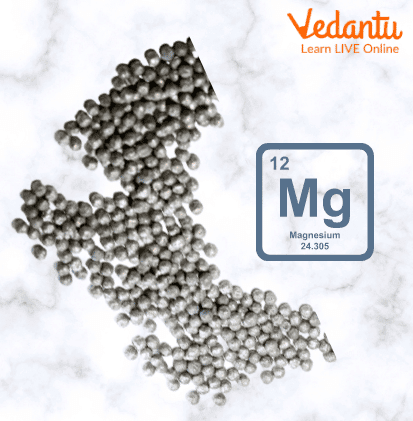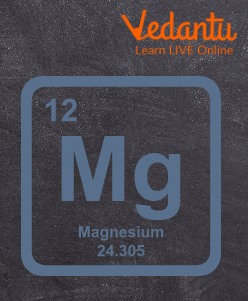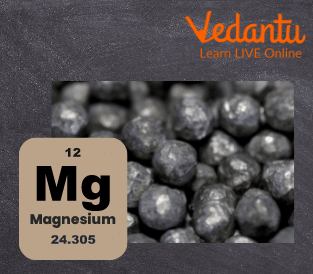




Why Is Magnesium Essential in the Periodic Table?
Do you know that there are 118 elements in the periodic table, and magnesium is one of the most abundant and reactive metals on earth? It is one of the most chemically active alkaline earth metals (elements of group 2 of the periodic table). It is placed in the second row at the second position in the periodic table. Magnesium has 12 electrons and protons. Additionally, it has two valence electrons (negative particles that participate in chemical reactions) in the outer shell.

Magnesium Picture
Physical Properties of Magnesium
The physical properties of magnesium are as follows:
The magnesium symbol is 'Mg'.
Its atomic number and mass are 12 and 24.305, respectively.
It is a silvery-white element found in the solid state.
Its density is 1.738 grams per cubic centimetre, due to which it sinks in the water.
The melting and boiling points are 650°C and 1091°C.
It is lightweight and strong.
Chemical Properties of Magnesium
The chemical properties of magnesium are determined due to its high reactivity. These magnesium properties include the following:
High flammability, burns with a white flare at high temperatures.
React with oxygen and form oxides.
Reacts rapidly with hot water and slowly with cold water.
Combines with non-metals such as sulphur, phosphorus, and nitrogen to form compounds.
React with acids such as hydrochloric acid, sulphuric acid, etc.
Uses of Magnesium
Magnesium has multiple purposes ranging from chemical tests to everyday life uses. Here are its applications in different areas.

Magnesium
Chemical Uses
It produces different metals through reactions.
Used as a catalyst to increase the reaction rate.
Promotes organic reactions involving reduction, oxidation, etc.

Magnesium Chemical Reactions
Industrial Uses
Magnesium compounds are used to produce metals, cement, and glass. Some examples of magnesium metals are steel, iron, and non-ferrous metals.
Used in making bombs and explosives due to its high reactivity.
Used to make alloys for building construction.
Widely used for missile and aeroplane construction.
Helps to produce photographic plates in the printing industry.
It is used in flashlight photography and pyrotechnics (firework industry).
Helps to manufacture products such as laptops, car seats, luggage bags, power tools, and cameras.
Works as a purifier to remove sulphur from steel and molten iron.

Magnesium Flare
Biological Uses
Magnesium is a significant element for plant and animal growth and development.
In plants, it helps make chlorophyll, a pigment that captures sunlight to make food.
It promotes photosynthesis.
Plants can suffer from conditions such as stunted growth, cell death, and drying of leaves due to the lack of magnesium.
In humans, it is involved in more than 300 biochemical reactions, including energy production, gene maintenance, protein formation, nervous system regulation, muscle movements, etc.
It helps remove blood sugar from the body and enhances exercise performance.
Increases muscle mass and power.
It regulates brain functions and swinging moods.
It may help decrease symptoms of anxiety and depression.
It can cure diabetes.
Magnesium plays a critical role in keeping heart muscles healthy.
It decreases the risk of stroke, high blood pressure, and heart diseases.
It has anti-aging and anti-inflammatory properties.
Increases immunity to fight against diseases.
Prevent migraine attacks and treat headaches.
Promote bone health and prevent bone disorders like osteoporosis.

Magnesium Supplements
Everyday Uses
The everyday uses of magnesium include the following:
It helps reduce menstrual symptoms such as abdominal cramps, back pain, fatigue, etc.
It decreases tiredness and increases energy.
It reduces the chances of fractures.
Treats sleep disorders and improves sleep quality.
Summary
Magnesium is a naturally occurring element that exists in a chemical compound form due to its hyper-reactive nature. It appears in a solid state and is found in mineral decompositions. It comes with numerous benefits and applications varying from chemical to daily-life applications.
FAQs on Magnesium in the Periodic Table: Properties, Uses & Importance
1. What are the isotopes of magnesium?
Isotopes are two or more species of atoms of an element that have the same atomic number and position in the periodic table. Isotopic molecules have similar chemical properties but have different atomic mass and physical properties. For example, magnesium has three isotopes, Mg-24, Mg-25, and Mg-26. Mg-24 is the most common isotope found on the earth. These isotopes exhibit similar chemical properties but have different physical properties, including differences in mass, density, melting, and boiling point.
2. Where is magnesium found on the earth?
Magnesium is the eighth-most abundant element on the earth's crust and exists in a combined form. This means that it does not exist in the free state. It is found in massive mineral deposits such as dolomite and magnesite. The water bodies contain tonnes of magnesium. Each year 850,000 tonnes of magnesium are produced through chemical and electrical processes.









